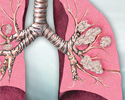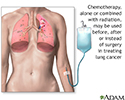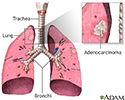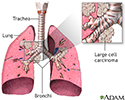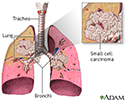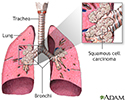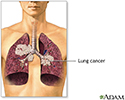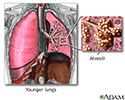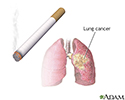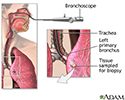Lung cancer - small cell
Cancer - lung - small cell; Small cell lung cancer; SCLC
Small cell lung cancer (SCLC) is a fast-growing type of lung cancer. It spreads much more quickly than non-small cell lung cancer.
There are two types of SCLC:
- Small cell carcinoma (oat cell cancer)
- Combined small cell carcinoma
Most SCLCs are of the oat cell type.
Causes
About 15% of all lung cancer cases are SCLC. Small cell lung cancer is slightly more common in men than women.
Almost all cases of SCLC are due to cigarette smoking. SCLC is very rare in people who have never smoked.
SCLC is the most aggressive form of lung cancer. It usually starts in the breathing tubes (bronchi) in the center of the chest. Although the cancer cells are small, they grow very quickly and create large tumors. These tumors often spread rapidly (metastasize) to other parts of the body, including the brain, liver, and bone.
Symptoms
Symptoms of SCLC include:
- Bloody sputum (phlegm)
- Chest pain
- Cough
- Loss of appetite
- Shortness of breath
- Weight loss
- Wheezing
Other symptoms that may occur with this disease, especially in the late stages, include:
- Facial swelling
- Fever
- Hoarseness or changing voice
- Swallowing difficulty
- Weakness
Exams and Tests
The health care provider will perform a physical exam and ask about your medical history. You will be asked whether you smoke, and if so, how much and for how long.
When listening to your chest with a stethoscope, the provider may hear fluid around the lungs or areas where the lung has partially collapsed. Each of these findings may suggest cancer.
SCLC has usually spread to other parts of your body by the time it is diagnosed.
Tests that may be performed include:
- Bone scan
- Chest x-ray
- Complete blood count (CBC)
- CT scan
- Liver function tests
- MRI scan
- Positron emission tomography (PET) scan
- Sputum test (to look for cancer cells)
- Thoracentesis (removal of fluid from the chest cavity around the lungs)
In most cases, a piece of tissue is removed from your lungs or other areas to be examined under a microscope. This is called a biopsy. There are several ways to do a biopsy:
- Bronchoscopy combined with biopsy
- CT scan-directed needle biopsy
- Endoscopic esophageal or bronchial ultrasound with biopsy
- Mediastinoscopy with biopsy
- Open lung biopsy
- Pleural biopsy
- Video-assisted thoracoscopy
Usually, if a biopsy shows cancer, more imaging tests are done to find out the stage of the cancer. Stage means how big the tumor is and how far it has spread. SCLC is classified as either:
- Limited -- Cancer is only in the chest and can be treated with radiation therapy.
- Extensive -- Cancer has spread outside the area that can be covered by radiation.
Treatment
Because SCLC spreads quickly throughout the body, treatment will include cancer-killing drugs (chemotherapy), which are usually given through a vein (by IV).
Treatment with chemotherapy, and possibly radiation, may be done for people with SCLC that has spread throughout the body (extensive). In this case, the treatment only helps relieve symptoms and prolongs life, but does not cure the disease.
Radiation therapy can be used with chemotherapy if the disease is confined to one area within the chest (limited).
Radiation therapy uses powerful x-rays or other forms of radiation to kill cancer cells.
Radiation may be used to:
- Treat the cancer, along with chemotherapy, if surgery is not possible.
- Help relieve symptoms caused by the cancer, such as breathing problems and swelling.
- Help relieve cancer pain when the cancer has spread to the bones.
Often, SCLC may have already spread to the brain. This can occur even when there are no symptoms or other signs of cancer in the brain. As a result, some people with smaller cancers, or who had a good response in their first round of chemotherapy, may receive radiation therapy to the brain. This therapy is done to prevent spread of the cancer to the brain.
Surgery helps very few people with SCLC because the disease has often spread by the time it is diagnosed. Surgery may be done when there is only one tumor that has not spread. If surgery is done, chemotherapy or radiation therapy is still needed.
Support Groups
You can ease the stress of illness by joining a cancer support group. Sharing with others who have common experiences and problems can help you not feel alone.
Outlook (Prognosis)
How well you do depends on how much the lung cancer has spread. SCLC is very deadly. Not many people with this type of cancer are still alive 5 years after diagnosis.
Treatment can often prolong life for 6 to 12 months, even when the cancer has spread.
In rare cases, if SCLC is diagnosed early, treatment may result in a long-term cure.
When to Contact a Medical Professional
Contact your provider if you have symptoms of lung cancer, particularly if you smoke.
Prevention
If you smoke, now is the time to quit. If you are having trouble quitting, talk with your provider. There are many methods to help you quit, from support groups to prescription medicines. Also try to avoid secondhand smoke.
If you smoke or used to smoke, talk with your provider about getting screened for lung cancer. To get screened, you need to have a CT scan of the chest.
References
Araujo LH, Horn L, Merritt RE, Shilo K, Xu-Welliver M, Carbone DP. Cancer of the lung: non-small cell lung cancer and small cell lung cancer. In: Niederhuber JE, Armitage JO, Kastan MB, Doroshow JH, Tepper JE, eds. Abeloff's Clinical Oncology. 6th ed. Philadelphia, PA: Elsevier; 2020:chap 69.
National Comprehensive Cancer Network website. NCCN clinical practice guidelines in oncology: small cell lung cancer. Version 2.2022. www.nccn.org/professionals/physician_gls/pdf/sclc.pdf. Updated November 24, 2021. Accessed November 29, 2021.
National Cancer Institute website. Small cell lung cancer treatment (PDQ) - health professional version. www.cancer.gov/types/lung/hp/small-cell-lung-treatment-pdq. Updated April 14, 2022. Accessed May 17, 2022.
Rivera MP, Mody GN, Weiner AA. Lung cancer: treatment. In: Broaddus VC, Ernst JD, Talmadge EK, et al, eds. Murray and Nadel's Textbook of Respiratory Medicine. 7th ed. Philadelphia, PA: Elsevier; 2022:chap 77.
Lung cancer
Animation
Bronchoscopy - illustration
Bronchoscopy
illustration
Lungs - illustration
Lungs
illustration
Lung cancer - lateral chest x-ray - illustration
Lung cancer - lateral chest x-ray
illustration
Lung cancer - frontal chest X-ray - illustration
Lung cancer - frontal chest X-ray
illustration
Adenocarcinoma - chest x-ray - illustration
Adenocarcinoma - chest x-ray
illustration
Bronchial cancer - CT scan - illustration
Bronchial cancer - CT scan
illustration
Bronchial cancer - chest X-ray - illustration
Bronchial cancer - chest X-ray
illustration
Lung with squamous cell cancer - CT scan - illustration
Lung with squamous cell cancer - CT scan
illustration
Lung cancer - chemotherapy treatment - illustration
Lung cancer - chemotherapy treatment
illustration
Adenocarcinoma - illustration
Adenocarcinoma
illustration
Non-small cell carcinoma - illustration
Non-small cell carcinoma
illustration
Small cell carcinoma - illustration
Small cell carcinoma
illustration
Squamous cell carcinoma - illustration
Squamous cell carcinoma
illustration
Secondhand smoke and lung cancer - illustration
Secondhand smoke and lung cancer
illustration
Normal lungs and alveoli - illustration
Normal lungs and alveoli
illustration
Respiratory system - illustration
Respiratory system
illustration
Smoking hazards - illustration
Smoking hazards
illustration
Bronchoscope - illustration
Bronchoscope
illustration
Bronchoscopy - illustration
Bronchoscopy
illustration
Lungs - illustration
Lungs
illustration
Lung cancer - lateral chest x-ray - illustration
Lung cancer - lateral chest x-ray
illustration
Lung cancer - frontal chest X-ray - illustration
Lung cancer - frontal chest X-ray
illustration
Adenocarcinoma - chest x-ray - illustration
Adenocarcinoma - chest x-ray
illustration
Bronchial cancer - CT scan - illustration
Bronchial cancer - CT scan
illustration
Bronchial cancer - chest X-ray - illustration
Bronchial cancer - chest X-ray
illustration
Lung with squamous cell cancer - CT scan - illustration
Lung with squamous cell cancer - CT scan
illustration
Lung cancer - chemotherapy treatment - illustration
Lung cancer - chemotherapy treatment
illustration
Adenocarcinoma - illustration
Adenocarcinoma
illustration
Non-small cell carcinoma - illustration
Non-small cell carcinoma
illustration
Small cell carcinoma - illustration
Small cell carcinoma
illustration
Squamous cell carcinoma - illustration
Squamous cell carcinoma
illustration
Secondhand smoke and lung cancer - illustration
Secondhand smoke and lung cancer
illustration
Normal lungs and alveoli - illustration
Normal lungs and alveoli
illustration
Respiratory system - illustration
Respiratory system
illustration
Smoking hazards - illustration
Smoking hazards
illustration
Bronchoscope - illustration
Bronchoscope
illustration
Review Date: 7/19/2021
Reviewed By: Todd Gersten, MD, Hematology/Oncology, Florida Cancer Specialists & Research Institute, Wellington, FL. Review provided by VeriMed Healthcare Network. Also reviewed by David Zieve, MD, MHA, Medical Director, Brenda Conaway, Editorial Director, and the A.D.A.M. Editorial team. Editorial update 05/17/2022.


















